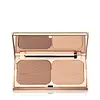What's inside
What's inside
 Key Ingredients
Key Ingredients

 Benefits
Benefits

No benefits
 Concerns
Concerns

 Ingredients Side-by-side
Ingredients Side-by-side

Mica
Cosmetic ColorantIsononyl Isononanoate
EmollientOryza Sativa Starch
AbsorbentDimethicone
EmollientZea Mays Starch
AbsorbentZinc Stearate
Cosmetic ColorantCaprylyl Glycol
EmollientPhenoxyethanol
PreservativeDimethiconol
EmollientHexylene Glycol
EmulsifyingPolymethylsilsesquioxane
Silica
AbrasiveTrimethylsiloxysilicate
EmollientTin Oxide
AbrasiveCI 77891
Cosmetic ColorantIron Oxides
Octyldodecyl Stearoyl Stearate
EmollientSynthetic Fluorphlogopite
Talc
AbrasiveBoron Nitride
AbsorbentMica
Cosmetic ColorantPolyethylene
AbrasiveDimethicone
EmollientCetearyl Ethylhexanoate
EmollientTrimethylsiloxysilicate
EmollientDimethiconol Stearate
EmollientLauroyl Lysine
Skin ConditioningHydrogen Dimethicone
Triethoxycaprylylsilane
Sodium Dehydroacetate
PreservativeCaprylyl Glycol
EmollientEthylhexylglycerin
Skin ConditioningTocopherol
AntioxidantCI 77891
Cosmetic ColorantCI 77492
Cosmetic ColorantCI 77491
Cosmetic ColorantSynthetic Fluorphlogopite, Talc, Boron Nitride, Mica, Polyethylene, Dimethicone, Cetearyl Ethylhexanoate, Trimethylsiloxysilicate, Dimethiconol Stearate, Lauroyl Lysine, Hydrogen Dimethicone, Triethoxycaprylylsilane, Sodium Dehydroacetate, Caprylyl Glycol, Ethylhexylglycerin, Tocopherol, CI 77891, CI 77492, CI 77491
 Reviews
Reviews

Ingredients Explained
These ingredients are found in both products.
Ingredients higher up in an ingredient list are typically present in a larger amount.
Caprylyl Glycol is a humectant and emollient, meaning it attracts and preserves moisture.
It is a common ingredient in many products, especially those designed to hydrate skin. The primary benefits are retaining moisture, skin softening, and promoting a healthy skin barrier.
Though Caprylyl Glycol is an alcohol derived from fatty acids, it is not the kind that can dry out skin.
This ingredient is also used as a preservative to extend the life of products. It has slight antimicrobial properties.
Learn more about Caprylyl GlycolCi 77891 is a white pigment from Titanium dioxide. It is naturally found in minerals such as rutile and ilmenite.
It's main function is to add a white color to cosmetics. It can also be mixed with other colors to create different shades.
Ci 77891 is commonly found in sunscreens due to its ability to block UV rays.
Learn more about CI 77891Dimethicone is a type of synthetic silicone created from natural materials such as quartz.
What it does:
Dimethicone comes in different viscosities:
Depending on the viscosity, dimethicone has different properties.
Ingredients lists don't always show which type is used, so we recommend reaching out to the brand if you have questions about the viscosity.
This ingredient is unlikely to cause irritation because it does not get absorbed into skin. However, people with silicone allergies should be careful about using this ingredient.
Note: Dimethicone may contribute to pilling. This is because it is not oil or water soluble, so pilling may occur when layered with products. When mixed with heavy oils in a formula, the outcome is also quite greasy.
Learn more about DimethiconeMica is a naturally occurring mineral used to add shimmer and color in cosmetics. It can also help improve the texture of a product or give it an opaque, white/silver color.
Serecite is the name for very fine but ragged grains of mica.
This ingredient is often coated with metal oxides like titanium dioxide. Trace amounts of heavy metals may be found in mica, but these metals are not harmful in our personal products.
Mica has been used since prehistoric times throughout the world. Ancient Egyptian, Indian, Greek, Roman, Aztec, and Chinese civilizations have used mica.
Learn more about MicaThis silicone is an emollient. Emollients create a thin film on the skin to prevent moisture from escaping.
It is not soluble in water and helps increase water-resistance in products.
According to a manufacturer, it can blend seamlessly with silicone oils, such as Cyclopentasiloxane.
Learn more about Trimethylsiloxysilicate